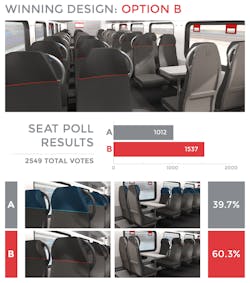In a recent survey, Caltrain asked riders for their opinion about what color seats they would like to see inside of the new high-performance electric trains as part of the Caltrain Electrification Project and the results are in.
Approximately 2,549 total votes were cast on the seat color poll, which was open to the public from July 20-28. Of those votes, 60.3 percent of the participants chose Option B, with Option A coming in at 39.7 percent.
Participants of the poll were able to vote online, and some customers were able to select their preference in person during station outreaches where seats were displayed in San Francisco, San Mateo and San Jose. During those outreaches, people were able to feel the new seats and try them out by sitting on them.
In April, Caltrain launched the www.calmodtrains.com website to allow the public to provide input on the look and feel of the next generation of the system’s trains. Users of the website can learn about some of the new electric train features, including more plentiful electrical outlets, better location and destination information, increased system-wide capacity and the configuration of passenger and bike cars.
The new website allows the public to provide continued feedback on many design options over the next several months. Next year, after feedback on the design is complete, the site will feature a 360-degree virtual tour of the new trains. Caltrain is preparing for its next poll in August where we will ask for public input on bike storage.
The $1.98 billion Electrification Project will upgrade the performance, operating efficiency, safety, and reliability of Caltrain’s commuter rail service. It will provide Peninsula communities with a state-of-the-art, modernized rail service that reduces travel time, increases capacity and helps relieve congestion on one of the nation’s most important transportation corridors.
Converting service from diesel equipment to high-performance electric trains will transform travel between San Jose and San Francisco. Electrification builds the foundation for future capacity expansion to accommodate job and population growth, while creating opportunities for new regional and statewide mobility options.




